Quantifying the Provincial Carbon Emissions of China Embodied in Trade: The Perspective of Land Use
Abstract
1. Introduction
2. Study Area and Data Sources
2.1. Study Area
2.2. Data Sources and Processing
3. Methods
3.1. Telecoupling Framework
3.2. Quantifying Land-Use Carbon Emissions Based on Energy Consumption
3.3. Modeling the Flows of Land Use-Based Embodied Carbon Emissions
4. Results
4.1. Land Use-Based Embodied Carbon Emissions from the Production and Consumption Ends
4.1.1. Land Use-Based Embodied Carbon Emissions from the Production End
4.1.2. Land Use-Based Embodied Carbon Emissions from the Consumption End
4.2. Net Transfer of Land Use-Based Embodied Carbon Emissions of Provinces
4.3. Network of Land Use-Based Embodied Carbon Emission Transfer
5. Discussion
6. Conclusions
Author Contributions
Funding
Data Availability Statement
Conflicts of Interest
References
- Karl, T.R.; Trenberth, K.E. Modern global climate change. Science 2003, 302, 1719–1723. [Google Scholar]
- Houghton, R.A. Interannual variability in the global carbon cycle. J. Geophys. Res. Atmos. 2000, 105, 20121–20130. [Google Scholar]
- Friedlingstein, P.; O’Sullivan, M.; Jones, M.W.; Andrew, R.M.; Gregor, L.; Hauck, J.; Le Quéré, C.; Luijkx, I.T.; Olsen, A.; Peters, G.P.; et al. Global Carbon Budget 2022. Earth Syst. Sci. Data 2022, 14, 4811–4900. [Google Scholar]
- Bruckner, B.; Hubacek, K.; Shan, Y.; Zhong, H.; Feng, K. Impacts of Poverty Alleviation on National and Global Carbon Emissions. Nat. Sustain. 2022, 5, 311–320. [Google Scholar] [CrossRef]
- Wang, Y.; Xiong, S.; Ma, X. Carbon Inequality in Global Trade: Evidence from the Mismatch between Embodied Carbon Emissions and Value Added. Ecol. Econ. 2022, 195, 107398. [Google Scholar] [CrossRef]
- Hong, C.; Zhao, H.; Qin, Y.; Burney, J.A.; Pongratz, J.; Hartung, K.; Liu, Y.; Moore, F.C.; Jackson, R.B.; Zhang, Q.; et al. Land-Use Emissions Embodied in International Trade. Science 2022, 376, 597–603. [Google Scholar] [CrossRef] [PubMed]
- Zhao, N.; Xu, L.; Malik, A.; Song, X.; Wang, Y. Inter-provincial trade driving energy consumption in China. Resour. Conserv. Recycl. 2018, 134, 329–335. [Google Scholar]
- Zhu, M.; Zhao, Z.; Meng, Y.; Chen, J.; Yu, Z.; Meng, C. Unfolding the Evolution of Carbon Inequality Embodied in Inter-Provincial Trade of China: Network Perspective Analysis. Environ. Impact Assess. Rev. 2022, 97, 106884. [Google Scholar]
- Henders, S.; Persson, U.M.; Kastner, T. Trading forests: Land-use change and carbon emissions embodied in production and exports of forest-risk commodities. Environ. Res. Lett. 2015, 10, 125012. [Google Scholar]
- Chuai, X.; Huang, X.; Qi, X.; Li, J.; Zuo, T.; Lu, Q.; Li, J.; Wu, C.; Zhao, R. A Preliminary Study of the Carbon Emissions Reduction Effects of Land Use Control. Sci. Rep. 2016, 6, 36901. [Google Scholar]
- Sato, M. Embodied Carbon in Trade: A Survey of the Empirical Literature. J. Econ. Surv. 2013, 28, 831–861. [Google Scholar]
- Zhang, B.; Bai, S.; Ning, Y.; Ding, T.; Zhang, Y. Emission Embodied in International Trade and Its Responsibility from the Perspective of Global Value Chain: Progress, Trends, and Challenges. Sustainability 2020, 12, 3097. [Google Scholar] [CrossRef]
- Peters, G.P. Carbon Footprints and Embodied Carbon at Multiple Scales. Curr. Opin. Environ. Sustain. 2010, 2, 245–250. [Google Scholar] [CrossRef]
- Qian, Y.; Zheng, H.; Meng, J.; Shan, Y.; Zhou, Y.; Guan, D. Large Inter-City Inequality in Consumption-Based CO2 Emissions for China’s Pearl River Basin Cities. Resour. Conserv. Recycl. 2022, 176, 105923. [Google Scholar] [CrossRef]
- Wang, H.; Fujita, T. A Review of Research on Embodied Carbon in International Trade. Sustainability 2023, 15, 7879. [Google Scholar] [CrossRef]
- Chuai, X.; Huang, X.; Wang, W.; Zhao, R.; Zhang, M.; Wu, C. Land use, total carbon emissions change and low carbon land management in Coastal Jiangsu, China. J. Clean. Prod. 2015, 103, 77–86. [Google Scholar]
- Zhou, Y.; Chen, M.; Tang, Z.; Mei, Z. Urbanization, Land Use Change, and Carbon Emissions: Quantitative Assessments for City-Level Carbon Emissions in Beijing-Tianjin-Hebei Region. Sustain. Cities Soc. 2021, 66, 102701. [Google Scholar] [CrossRef]
- Liu, J.; Hull, V.; Batistella, M.; DeFries, R.; Dietz, T.; Fu, F.; Hertel, T.W.; Izaurralde, R.C.; Lambin, E.F.; Li, S. Framing Sustainability in a Telecoupled World. Ecol. Soc. 2013, 18, 26. [Google Scholar] [CrossRef]
- Seto, K.C.; Reenberg, A.; Boone, C.G.; Fragkias, M.; Haase, D.; Langanke, T.; Marcotullio, P.; Munroe, D.K.; Olah, B.; Simon, D. Urban land teleconnections and sustainability. Proc. Natl. Acad. Sci. USA 2012, 109, 7687–7692. [Google Scholar]
- Sun, J.; Mooney, H.; Wu, W.; Tang, H.; Tong, Y.; Xu, Z.; Huang, B.; Cheng, Y.; Yang, X.; Wei, D. Importing Food Damages Domestic Environment: Evidence from Global Soybean Trade. Proc. Natl. Acad. Sci. USA 2018, 115, 5415–5419. [Google Scholar]
- Shi, K.; Chen, Y.; Yu, B.; Xu, T.; Chen, Z.; Liu, R.; Li, L.; Wu, J. Modeling Spatiotemporal CO2 (Carbon Dioxide) Emission Dynamics in China from DMSP-OLS Nighttime Stable Light Data Using Panel Data Analysis. Appl. Energy 2016, 168, 523–533. [Google Scholar] [CrossRef]
- Liu, X.; Klemeš, J.J.; Varbanov, P.S.; Čuček, L.; Qian, Y. Virtual carbon and water flows embodied in international trade: A review on consumption-based analysis. J. Clean. Prod. 2017, 146, 20–28. [Google Scholar]
- Arneth, A.; Sitch, S.; Pongratz, J.; Stocker, B.D.; Ciais, P.; Poulter, B.; Bayer, A.D.; Bondeau, A.; Calle, L.; Chini, L.P.; et al. Historical carbon dioxide emissions caused by land-use changes are possibly larger than assumed. Nat. Geosci. 2017, 10, 79–84. [Google Scholar]
- Liu, M.; Chen, Y.; Chen, K.; Chen, Y. Progress and Hotspots of Research on Land-Use Carbon Emissions: A Global Perspective. Sustainability 2023, 15, 7245. [Google Scholar] [CrossRef]
- Liu, C.; Hu, S.; Wu, S.; Song, J.; Li, H. County-level land use carbon emissions in China: Spatiotemporal patterns and impact factors. Sustain. Cities Soc. 2024, 105, 105304. [Google Scholar]
- Friis, C.; Nielsen, J.Ø. Land-use change in a telecoupled world: The relevance and applicability of the telecoupling framework in the case of banana plantation expansion in Laos. Ecol. Soc. 2017, 22, 30. [Google Scholar] [CrossRef]
- Wang, Y.; Hong, S.; Wang, J.; Lin, J.; Mu, H.; Wei, L.; Wang, Z.; Bryan, B.A. Complex Regional Telecoupling between People and Nature Revealed via Quantification of Trans-boundary Ecosystem Service Flows. People Nat. 2022, 4, 274–292. [Google Scholar]
- Fang, C.; Ren, Y. Analysis of Emergy-Based Metabolic Efficiency and Environmental Pressure on the Local Coupling and Telecoupling between Urbanization and the Eco-Environment in the Beijing-Tianjin-Hebei Urban Agglomeration. Sci. China Earth Sci. 2017, 60, 1083–1097. [Google Scholar] [CrossRef]
- Chuai, X.; Gao, R.; Huang, X.; Lu, Q.; Zhao, R. The Embodied Flow of Built-up Land in China’s Interregional Trade and Its Implications for Regional Carbon Balance. Ecol. Econ. 2021, 184, 106993. [Google Scholar] [CrossRef]
- Wang, P.; Li, H.; Huang, Z. The Inter-Provincial Trade Inequality in China: An Assessment of the Impact of Changes in Built-up Land and Carbon Storage. Ecol. Econ. 2023, 206, 107749. [Google Scholar] [CrossRef]
- Gao, R.; Chuai, X.; Ge, J.; Wen, J.; Zhao, R.; Zuo, T. An Integrated Tele-Coupling Analysis for Requisition–Compensation Balance and Its Influence on Carbon Storage in China. Land Use Policy 2022, 116, 106057. [Google Scholar] [CrossRef]
- Xia, X.; Ren, P.; Wang, X.; Liu, D.; Chen, X.; Dan, L.; He, B.; He, H.; Ju, W.; Liang, M.; et al. The carbon budget of China: 1980-2021. Sci. Bull. 2024, 69, 114–124. [Google Scholar] [CrossRef]
- Liu, Z.; Meng, J.; Deng, Z.; Lu, P.; Guan, D.; Zhang, Q.; He, K.; Gong, P. Embodied carbon emissions in China-US trade. Sci. China Earth Sci. 2020, 63, 1577–1586. [Google Scholar] [CrossRef]
- Zhou, Y.; Li, X.; Liu, Y. Land Use Change and Driving Factors in Rural China during the Period 1995-2015. Land Use Policy 2020, 99, 105048. [Google Scholar] [CrossRef]
- Guo, J.; Zhang, Z.; Meng, L. China’s provincial CO2 emissions embodied in international and interprovincial trade. Energy Policy 2012, 42, 486–497. [Google Scholar] [CrossRef]
- Li, B.; Wang, C.; Wang, Y.; Wang, W.; Lin, A. Impact Assessment of China’s Inter-Provincial Trade on Trade-Related Sustainable Development Goals. J. Clean. Prod. 2023, 388, 135983. [Google Scholar] [CrossRef]
- Mi, Z.; Meng, J.; Guan, D.; Shan, Y.; Song, M.; Wei, Y.-M.; Liu, Z.; Hubacek, K. Chinese CO2 Emission Flows Have Reversed since the Global Financial Crisis. Nat. Commun. 2017, 8, 1712. [Google Scholar] [CrossRef] [PubMed]
- IPCC. 2006 IPCC Guidelines for National Greenhouse Gas Inventories. In Proceedings of the National Greenhouse Gas Inventories Programme, Intergovernmental Panel on Climate Change IPCC, c/o Institute for Global Environmental Strategies IGES, 2108–11, Hayama, Japan, 1 July 2006; Eggleston, H.S., Buendia, L., Miwa, K., Ngara, T., Tanabe, K., Eds.; IGES: Hayama, Japan, 2006. [Google Scholar]
- Shao, L.; Li, Y.; Feng, K.; Meng, J.; Shan, Y.; Guan, D. Carbon emission imbalances and the structural paths of Chinese regions. Appl. Energy 2018, 215, 396–404. [Google Scholar] [CrossRef]
- Peters, G.P. From Production-Based to Consumption-Based National Emission Inventories. Ecol. Econ. 2008, 65, 13–23. [Google Scholar] [CrossRef]
- Xue, R.; Wang, S.; Long, W.; Gao, G.; Liu, D.; Zhang, R. Uncovering GHG emission characteristics of industrial parks in Central China via emission inventory and cluster analysis. Energy Policy 2021, 151, 112191. [Google Scholar] [CrossRef]
- Liu, X.; Wang, S.; Wu, P.; Feng, K.; Hubacek, K.; Li, X.; Sun, L. Impacts of Urban Expansion on Terrestrial Carbon Storage in China. Environ. Sci. Technol. 2019, 53, 6834–6844. [Google Scholar] [CrossRef] [PubMed]
- Liu, X.; Wang, S.; Zhuang, Q.; Jin, X.; Bian, Z.; Zhou, M.; Meng, Z.; Han, C.; Guo, X.; Jin, W.; et al. A Review on Carbon Source and Sink in Arable Land Ecosystems. Land 2022, 11, 580. [Google Scholar] [CrossRef]
- Yan, B.; Xia, Y.; Jiang, X. Carbon Productivity and Value-Added Generations: Regional Heterogeneity along Global Value Chain. Struct. Change Econ. Dyn. 2023, 65, 111–125. [Google Scholar] [CrossRef]
- Liu, Z.; Dou, X.Y.; Yu, Y.; Tan, J.G.; Sun, T.C.; Meng, J. China’s Embodied Carbon Transfer in Global Trade. China J. Econom. 2023, 3, 1225–1242. [Google Scholar]

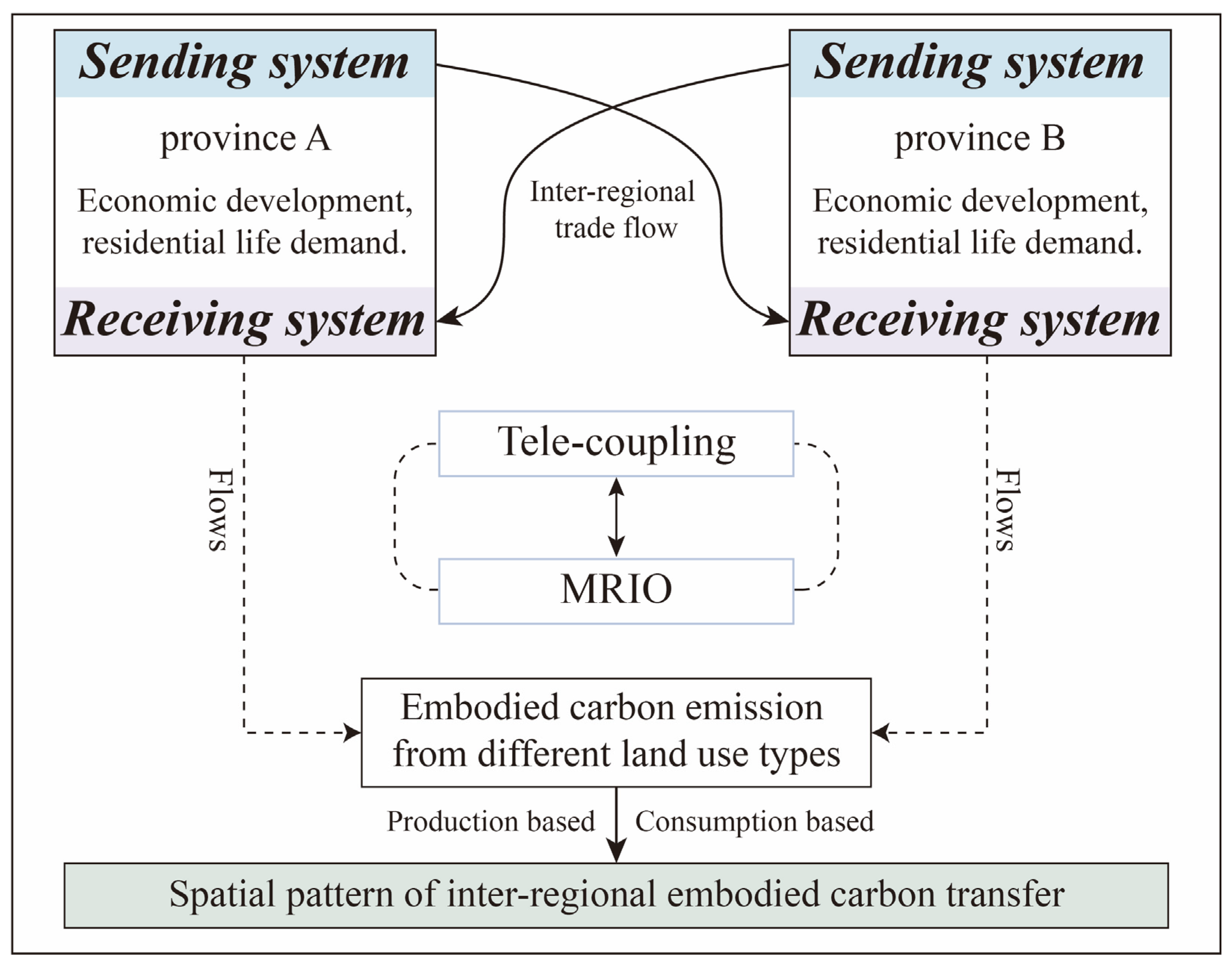
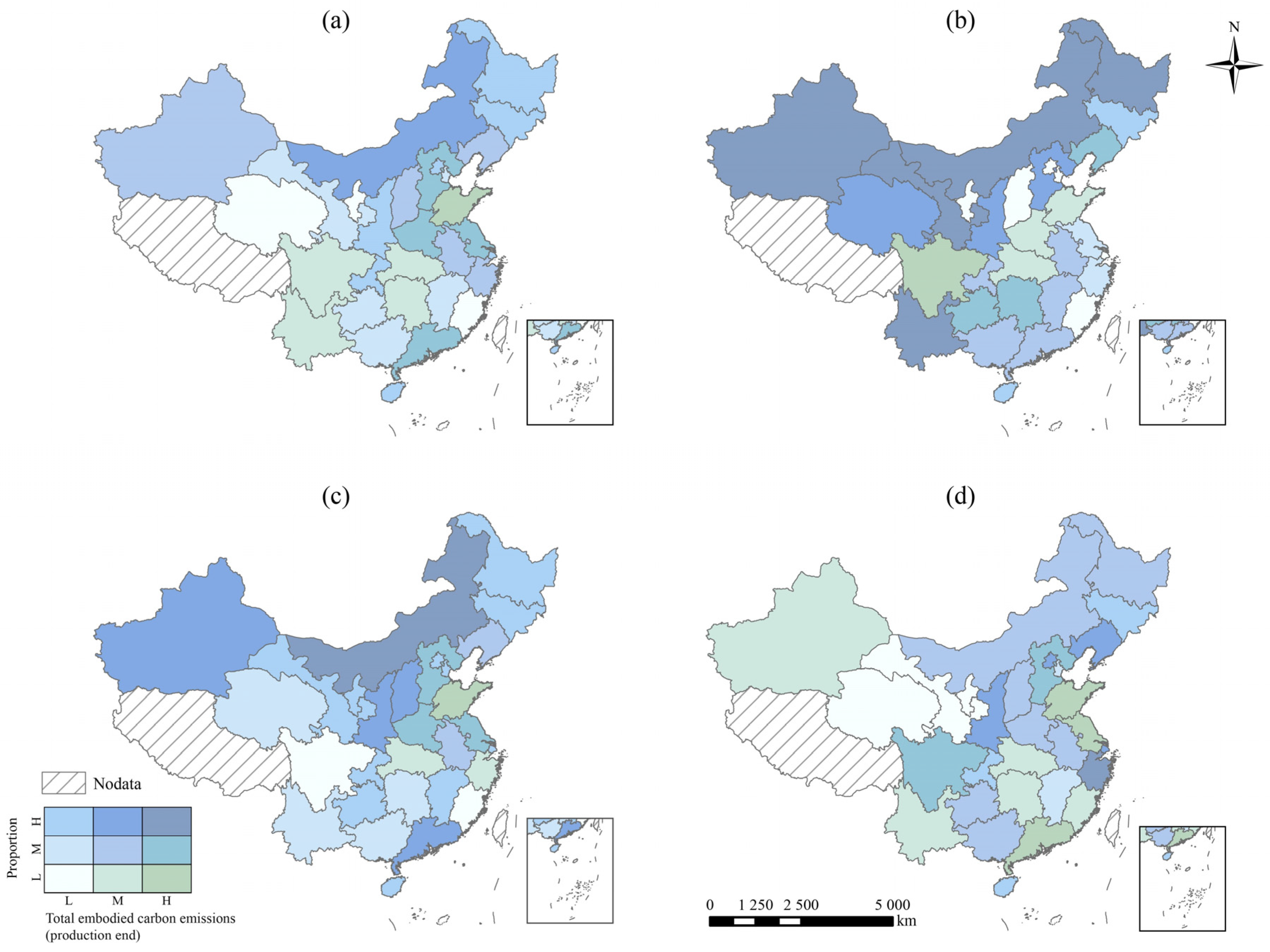
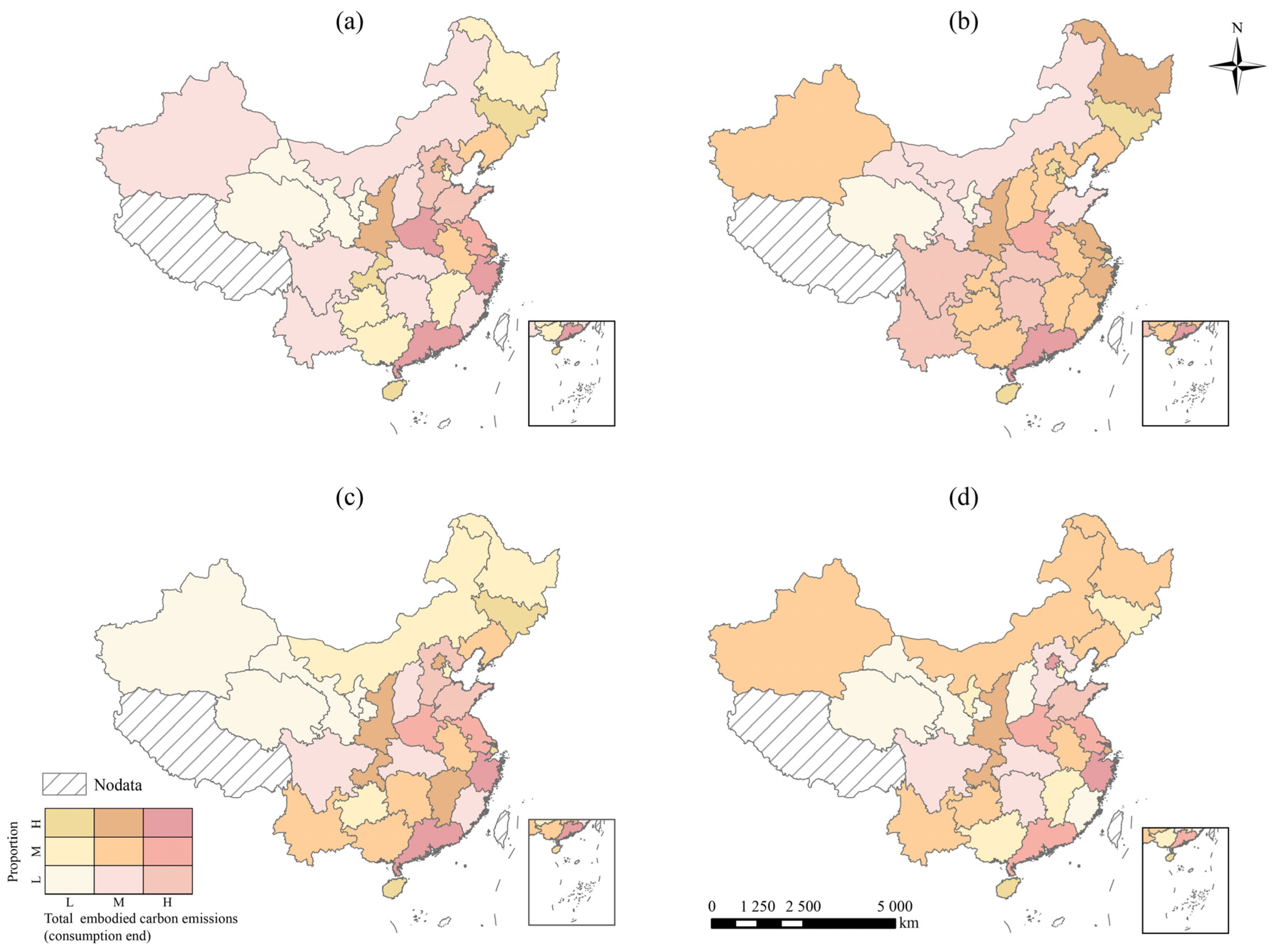
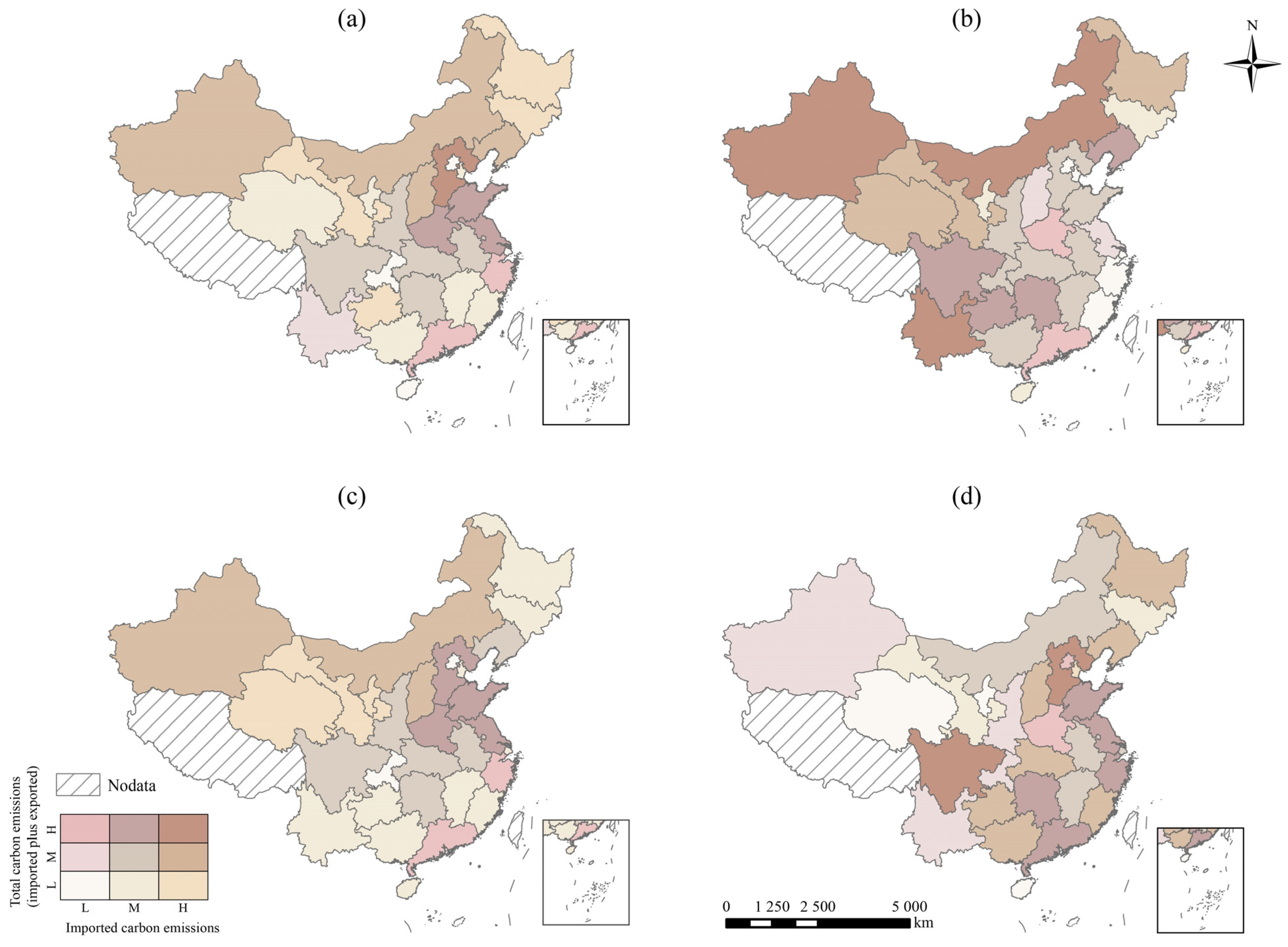
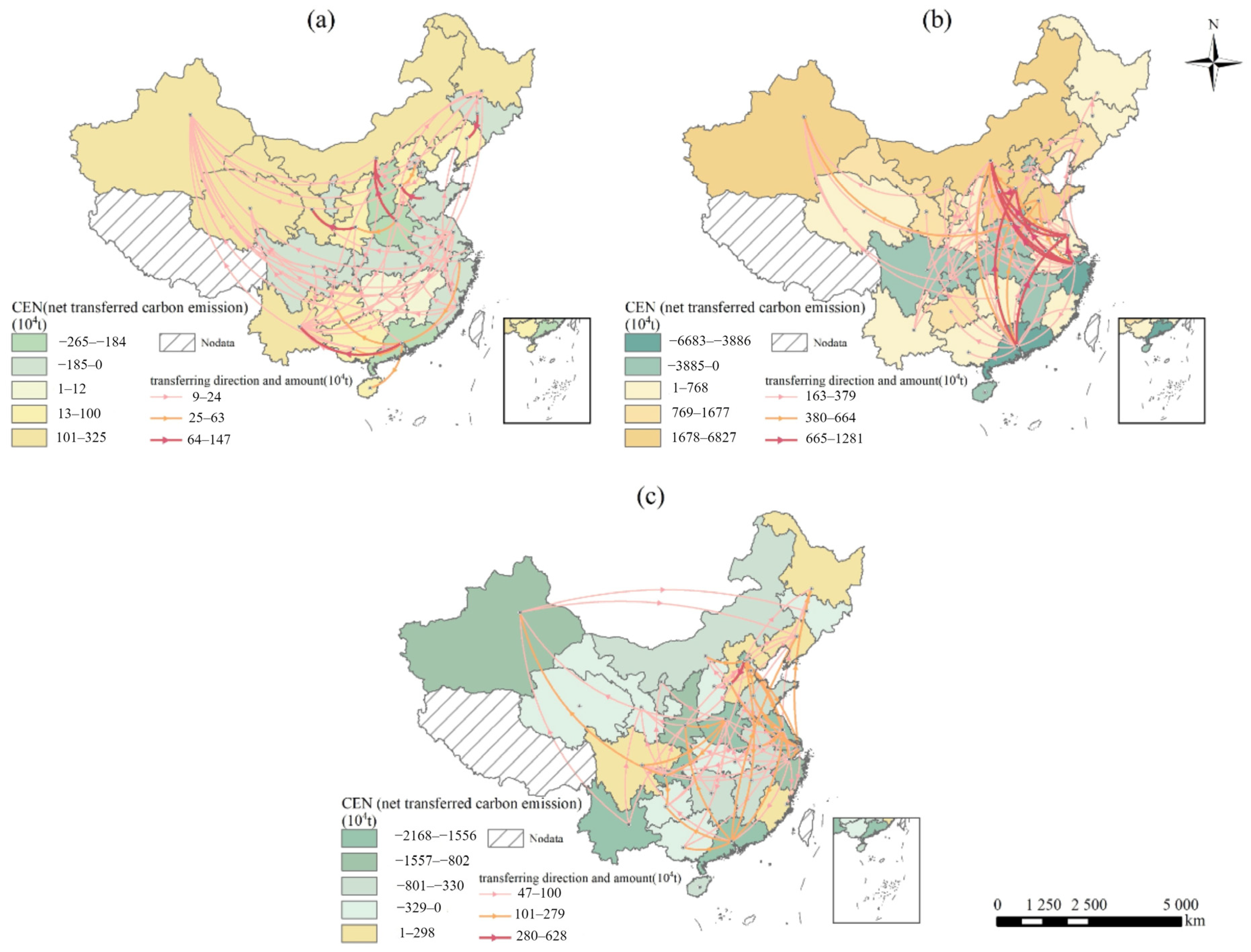

| Land Use Type (Level 1) | Land Use Type (Level 2) | Energy Consumption Items |
|---|---|---|
| Agricultural land | Cropland | Agriculture |
| Industrial land | Industrial and mining land | Industry |
| Construction land | Urban built-up land | Construction industry |
| Retail, wholesale, accommodation, and food services | ||
| Urban household consumption | ||
| Rural residential land | Rural household consumption | |
| Infrastructure land | Transportation, postal, and warehousing industry |
Disclaimer/Publisher’s Note: The statements, opinions and data contained in all publications are solely those of the individual author(s) and contributor(s) and not of MDPI and/or the editor(s). MDPI and/or the editor(s) disclaim responsibility for any injury to people or property resulting from any ideas, methods, instructions or products referred to in the content. |
© 2025 by the authors. Licensee MDPI, Basel, Switzerland. This article is an open access article distributed under the terms and conditions of the Creative Commons Attribution (CC BY) license (https://creativecommons.org/licenses/by/4.0/).
Share and Cite
Wu, Q.; Meng, J.; Yang, C.; Zhu, L. Quantifying the Provincial Carbon Emissions of China Embodied in Trade: The Perspective of Land Use. Land 2025, 14, 753. https://doi.org/10.3390/land14040753
Wu Q, Meng J, Yang C, Zhu L. Quantifying the Provincial Carbon Emissions of China Embodied in Trade: The Perspective of Land Use. Land. 2025; 14(4):753. https://doi.org/10.3390/land14040753
Chicago/Turabian StyleWu, Qiqi, Jijun Meng, Cuiyutong Yang, and Likai Zhu. 2025. "Quantifying the Provincial Carbon Emissions of China Embodied in Trade: The Perspective of Land Use" Land 14, no. 4: 753. https://doi.org/10.3390/land14040753
APA StyleWu, Q., Meng, J., Yang, C., & Zhu, L. (2025). Quantifying the Provincial Carbon Emissions of China Embodied in Trade: The Perspective of Land Use. Land, 14(4), 753. https://doi.org/10.3390/land14040753









